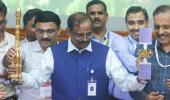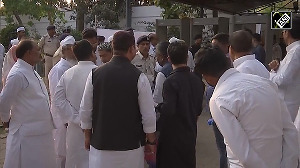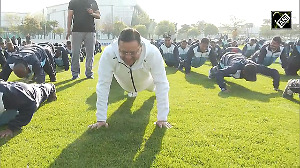ISRO's vendor policy and quality control processes are under scanner.

Indian Space Research Organisation's NVS-02 satellite Failure Analysis Committee headed by former ISRO chairman Alur Seelin Kiran Kumar should also look at the space agency's vendor policy, fool proof quality control process and other aspects.
ISRO has formed a Failure Analysis Committee to look into the causes for the pyro valve failure in India's latest navigation satellite NVS-02 orbited in January 2025.
"The work is already on with various data being studied. No timeframe has been set for the submission of the report," Kumar said.
The 2,250 kg NVS-02 costing about Rs 300 crore (Rs 3 billion) that was placed in the Geosynchronous Transfer Orbit (GTO) on January 29, 2025, is stuck there as its pyro valve did not open to pump in the oxidiser to fire the motors while the fuel pumps were working.
Only by firing the on-board liquid apogee motors can a satellite be taken to its intended orbital slot.
As per the original plan, the NVS-02 satellite was to be placed in a Geosynchronous Orbit over India so that it moves in line with earth's rotation.
ISRO in a statement on the NVS-02 status said the orbit raising operations towards positioning the satellite to the designated orbital slot could not be carried out as the valves for admitting the oxidiser to fire the thrusters for orbit raising did not.
The question is what is the proximate cause for the oxidiser valve not opening?
With the NVS-02 failure heat on, ISRO senior officials are not available for comment.
Industry experts and former senior ISRO officials speaking on condition of anonymity told this correspondent the power supply was not there for the value to open.
According to them, one of the probable reasons is that the power supply connector was not connected after the final tests for reasons not known.
As the stakes are high -- the total mission cost about Rs 600 crore (Rs 6 billion); a cost equally split between the rocket and the satellite -- critical systems will have redundancies.
In NVS-02, it is said, there was full redundancy in the valve and also electronics and power supplies.

So what could have happened in the case of power supply to NVS-02?
In this particular case, the main and redundant power was passing through the same connector which defeated the concept of full redundancy. There should be two separate connectors, an expert said.
Industry experts were of the view that critical systems in a rocket or in a satellite should have two/three full redundancies independent of each other.
Further the components sourced from different vendors avoid the risk of batch failures if sourced from a single vendor.
In the case of space craft carrying human beings, there should be three/four redundancies for critical systems.
ISRO follows a multiple vendor policy for fabrication, assembly jobs through rate contracts with multiple parties.
For procurement of components the space agency generally goes by general tender with L1 approach.
Sometimes, if the confidence levels with a vendor for a particular component is very high then the purchase is done on a proprietary basis.
As regards the NVS-02 the valves, power systems and connected electronics were made by ISRO, it is said.
ISRO follows a policy of two way redundancy in case of system configuration and in some cases four way redundancy for very critical operations like heat shield opening, said a retired senior ISRO official.
In 2017, the IRNSS-1H satellite (the replacement for IRNSS-1A) remained encapsulated in the Polar Satellite Launch Vehicle as its heat shield failed to open -- another multi-crore mission that failed.
Queried about their vendor policy a top official of a private satellite maker said the company follows a multi-vendor policy unless there is a paucity of choice.
In the case of critical systems it is always a double vendor policy. "In the case of systems with redundancy, we use different vendors for primary and the redundant/secondary," the official said.
While the systems in a satellite and rocket are checked prior to the flight, the fuel systems cannot be checked.
In recent times, there have been two major mission failures for ISRO -- in 2022, the first flight of the Small Satellite Launch Vehicle (SSLV) failed to deliver the satellites in the required orbit and now the NVS-02 satellite.
ISRO should have processes like 'poka-yoke' -- a Japanese term for error or mistake free -- in its manufacturing and quality testing processes.
Under the 'poka-yoke' process, if there is an error in a manufacturing process, then going to the next process will be difficult or impossible.
Meanwhile, it is learnt that the commissioning process of the NVS-02 satellite is going on.
While NVS-02 will be in an elliptical orbit and not circular, ISRO said it will nevertheless use the same for navigation purposes.
The satellite can be used for navigation purposes whenever it is over India and if all the systems work well but with a shortened life span, it is learnt.
Venkatachari Jagannathan can be reached at venkatacharijagannathan@gmail.com
Feature Presentation: Rajesh Alva/Rediff.com











 © 2025
© 2025